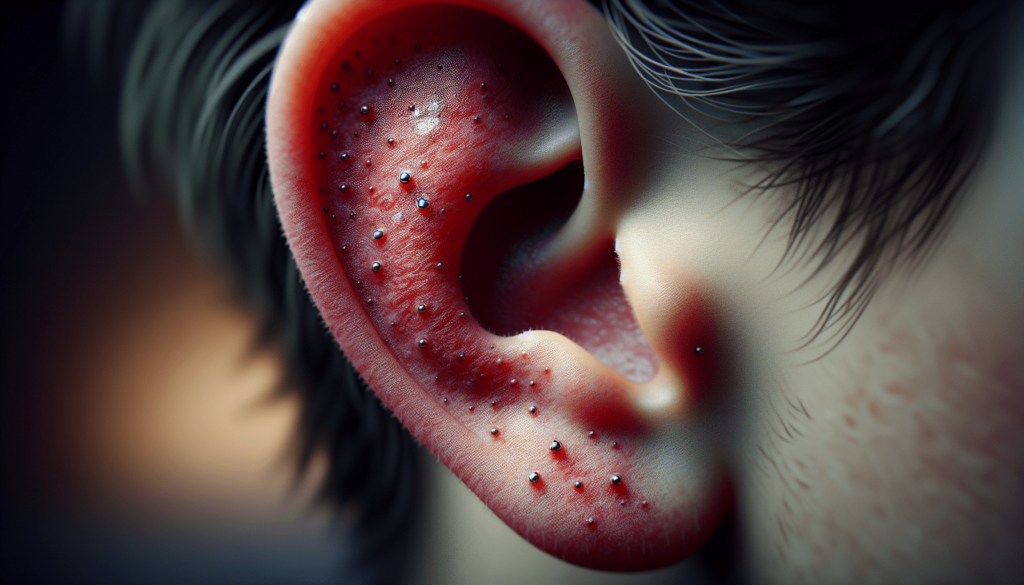Have you ever felt discomfort following an ear piercing and wondered if something might be amiss?
Understanding Ear Piercing Allergies
Ear piercings can be an exciting form of self-expression, but they can also occasionally lead to discomfort or irritation. For some, this irritation is not just the usual post-piercing sensation but a sign of an allergic reaction. In this article, we’ll explore the common signs of ear piercing allergies and what you can do to alleviate and prevent them.
What Causes Ear Piercing Allergies?
Sixteen-year-old you may have rushed with glee to the local piercing studio for a bit of ear bling, but what you didn’t know then was the science behind why your ears might not be as stoked about metal as you are. The main culprits behind ear piercing allergies are metals such as nickel, cobalt, and chromium, commonly found in jewelry. These metals can trigger an allergic reaction in susceptible individuals.
Some folks are more sensitive, not unlike that one friend who always tears up during a commercial. If you’re part of this sensitive group, your immune system may go on high alert, mistaking a harmless metal as a threat and launching an allergic response.
Common Signs of Ear Piercing Allergies
Recognizing the symptoms early on can save you a lot of discomfort and potential complications. Here’s what you should be on the lookout for.
Redness and Swelling
It’s perfectly normal for new piercings to have a bit of redness and swelling at first. Think of it like your ear’s way of saying, “I need a moment to adjust.” However, if the redness intensifies or spreads beyond the immediate area, it could indicate an allergic reaction. Similarly, swelling that doesn’t subside after a few days—or that inexplicably grows worse—might be your ear’s dramatic way of signaling it doesn’t like being pierced with that metal.
Itching and Burning Sensation
Another telltale sign of an allergic reaction is persistent itching or a burning sensation around the site of the piercing. It isn’t just a tickle that’ll make you giggle. No. It’s usually a nagging itch or a sensation that feels like you’re holding a tiny bonfire against your earlobe. Your body’s way of trying to get your attention, perhaps with tiny red flags aplenty.
Rash or Hives
While milder forms of skin irritation result in a hint of rash, a full-blown allergic reaction can lead to hives. These raised, itchy bumps are not so discreet in making themselves known. Essentially, your skin’s equivalent of angrily scribbling a note to say “We don’t like this!”
Abscess Formation
Sometimes, in an allergy’s effort to be noticed, it brings friends—like pus. If you notice a pocket of pus or a painful bump forming around your piercing, it’s time to pay attention. What began as a small adventure for adornment can escalate to a problematic abscess if left untreated.
Pain Beyond the Usual
A new piercing can be a bit sore—like trying on new shoes. But, if the pain continues rather than easing up, or you start feeling like you’ve been street fighting with a concrete wall whenever your earlobe is touched, something more sinister than regular healing might be happening.

Managing Ear Piercing Allergies
Once you identify these signs, the goal is to manage the symptoms effectively and prevent future occurrences.
Choosing the Right Metals
Fortify yourself with knowledge, much like a metal detective. Stick with hypoallergenic options like surgical-grade stainless steel, titanium, or gold (14k or higher). These metals are less likely to agitate your immune system, so your immune system won’t yell “Intruder!” every time you wear earrings.
In the table below, find a quick guide to safe metals for sensitive ears and those best avoided:
| Safe Metals | Metals to Avoid |
|---|---|
| Surgical Stainless Steel | Nickel |
| Titanium | Cobalt |
| Platinum | Chromium |
| 14k Gold or Higher | White Gold (often alloyed with nickel) |
Maintaining Proper Hygiene
If cleanliness is next to godliness, it’s also next to itch-free peace. Keep your piercing clean using a saline solution or an antiseptic recommended by your piercer. Ensure no foreign substances, like lotions or hair products, find their way near the fresh piercing until it’s healed. Your immune system will thank you through serene, unblemished skin.
Seeking Professional Help
If symptoms persist despite your best efforts, it may be time to consult a healthcare provider. A dermatologist or allergist can run tests to identify specific metal allergens, offering you personalized insights into your ear’s fussiness.
Preventing Future Allergies with Expert Guidance
Prevention is certainly better than dealing with rashes, itching, and yes, the added fragrance of pus. One of the most effective ways to prevent ear piercing allergies is to gain proper knowledge about ear piercing techniques and aftercare.
Enrolling in the Ear Piercing Online Course
At the Centre of Wellness, we understand the intricate relationship between piercing art and skin science. Our Ear Piercing Online Course is designed to cover the essentials of safe piercing practices and material selection. Through comprehensive modules, you’ll learn about different metals, safe aftercare practices, and strategies to prevent allergic reactions. By equipping yourself with in-depth knowledge, you’re not just caring for your ears but also making informed choices that pave the way for a joyful, allergy-free piercing experience.

Final Thoughts
Embellishing your ears is a delightful journey of personal style and identity, not without its hiccups. Now that you can recognize the signs of an ear piercing allergy, you can take better control over your jewelry choices and healthcare practices. Always consult experts when in doubt, and remember that your comfort and well-being are paramount. With the right knowledge and support, potential pitfalls can be transformed into stepping stones for a stress-free and stylish ear-piercing journey.


